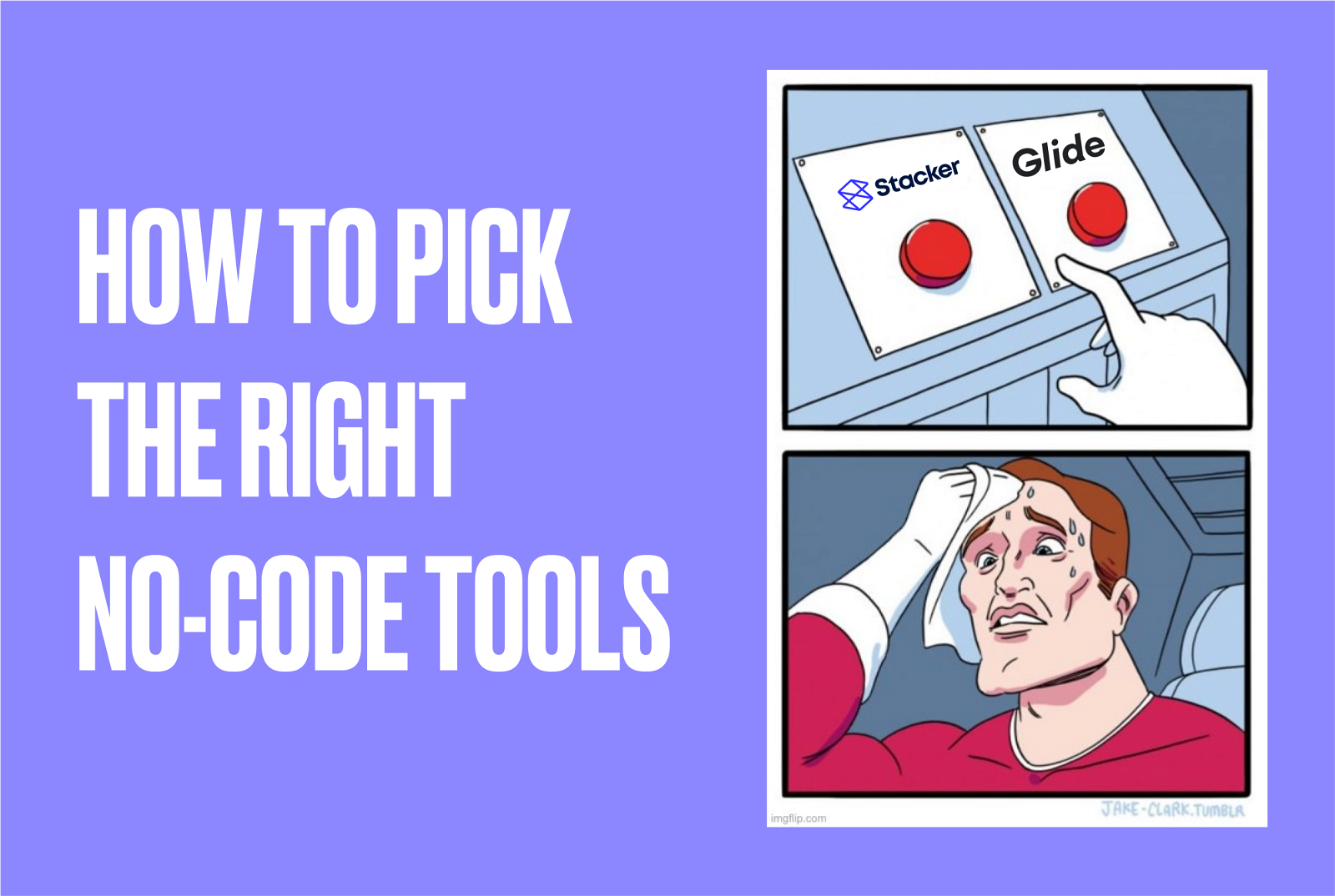How to choose the right no-code platform for your project
No, it's not just price and features. Read on to find out what the three critical factors are.
Table of Contents
Deciding which no-code platform is right for the project you have in mind involves a few factors. Here’s a simple outline to help you on your way.
For those sitting there thinking that choosing the perfect no-code tool comes down to a combination of price and features, we’ve got some news for you. And the news is: there’s a little more to it than that.
Though the size and scale of your business will dictate the kind of input you have on decision-making, if you are the one advocating for no-code, chances are you’ll also have a pretty big role in deciding which platform to go for. Oh, the power. Generally speaking, there are three key areas to consider:
1. The needs of the project
Logically, the app you want to create is going to dictate what kind of platform is right for you. For example, are you looking to build a web app, a mobile app or automations? Then it’s a case of speed. Do you want to build something quickly and get moving as soon as possible? If so, it makes sense to opt for a simpler tool with perhaps functionality and design freedom that’s easier to pick up. Conversely, perhaps you’re aiming to create a project with real longevity, and you’d like to take time to really learn the nuances of the platform and dig into all their learning materials. In that case, a more complex tool that gives more design freedom might be right.
It’s also important to consider the scale of the data you’ll be working with. For example, you might have a use case in mind that’s particularly data-intensive – like building a database of PR companies and their tweets. That could require millions of rows of data; not many no-code platforms can handle that.

2. The needs of your business
If you’re bringing a new platform or tool into your organisation, the specific needs and nuances of that setting have to be taken into account. Here, it’s worth considering what you need your app to do over the long term for the business. For example, if you’re building something in the healthcare sector in the US, it had better be HIPAA compliant. That means you’ll either need to work with a platform that hosts your data extremely securely or, more likely, you’ll need to self-host the data and secure it yourself. That kind of distinction immediately splits the no-code world in two.
Then, what do you need the platform to be able to integrate with when it comes to your organisation’s IT architecture? If your org uses Airtable then you need to make sure the tool you’ve chosen can integrate with that. Otherwise, it’s the wrong tool.
And, of course, does the pricing model of the tool work in the long term? Remember: there are several ways that no-code tools price their platforms, including by the user, by the app and for data storage. Perhaps you plan on building several apps; maybe you want one app to have thousands of users. These kinds of distinctions will matter when it comes to working out how much it’s going to cost.
3. The needs of the people you want to use it
You can broadly divide your options into three buckets:
- You go for a no-code platform that’s simple to use and has a very accessible learning curve. That will definitely cost you in terms of design freedom and flexibility but you’ll have fewer decisions to make when it comes to UI and creating the logic for your app.
- You go for a no-code platform that gives you way more design freedom and flexibility but takes longer to get used to and has a steeper learning curve.
- You have a high skill set within your organisation, and want a lot of creative freedom – effectively taking pixel-perfect designs and taking them to a no-code tool. Maybe you’re a designer. This is basically a low-code tool.
Take the age-old Glide v Adalo debate as an example. Glide apps look amazing (and modern) because it’s a pretty restrictive platform in terms of what you can do. You don’t have much design control. Adalo, meanwhile, looks slightly older but you can do what you want with it and create whatever interface you like. But you will need to build that yourself.
It’s also worth considering the extent to which the no-code tool can be implemented widely across the organisation. What’s the training element like? Does the tool/platform have great educational content, a dedicated support team and an ecosystem of helpful materials? If you’re a small business, this might not matter; if you’re a big business you’ll definitely need some backup.
The takeaway
There are three key areas to consider when choosing your no-code platform: project, organisation and people. Each has layers of complexity involved and it’ll ultimately be a case of understanding what your non-negotiables are and what areas you have to make a trade-off. But fail to consider all three and you’ll be wasting time and cash – and probably making the subject of no-code tools a non-starter for a long time to come.


Similar Tutorials
Want to read
more articles
like these?
Become a NoCode Member and get access to our community, discounts and - of course - our latest articles delivered straight to your inbox twice a month!











